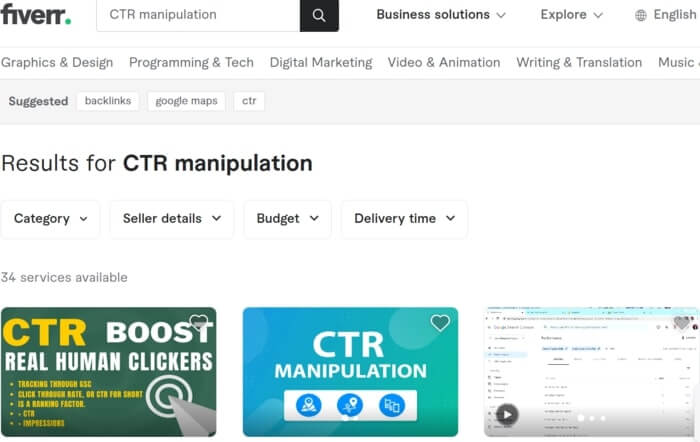Unlock Greater Positions with Reliable CTR Manipulation Approaches
Unlock Greater Positions with Reliable CTR Manipulation Approaches
Blog Article
Optimizing Organic Click-Through Rates With CTR Adjustment
The optimization of organic click-through rates (CTR) is a nuanced undertaking that hinges on recognizing both customer psychology and efficient web content discussion. By leveraging critical adjustment techniques, such as strongly crafted headings and visually engaging components, online marketers can dramatically improve customer interaction. Nonetheless, the landscape is raging with misunderstandings and oversimplifications about what really drives CTR. As we discover the intricacies of these strategies, it comes to be important to determine the underlying concepts that can result in sustained success in capturing target market interest. What genuinely distinguishes the effective from the inadequate in this critical aspect of digital marketing?
Comprehending Click-Through Rates
Understanding click-through prices (CTR) is crucial for reviewing the efficiency of on the internet advertising techniques. CTR gauges the portion of customers that click on a specific web link or advertisement contrasted to the overall number of users that see it. A higher CTR indicates that the material is engaging and pertinent to the target audience, while a lower CTR may signify a demand for optimization.
To determine CTR, divide the variety of clicks by the number of perceptions and increase by 100. If an ad receives 300 clicks out of 10,000 impacts, the CTR would certainly be 3%. This statistics is vital for examining numerous elements of digital advertising, including search engine optimization (SEO), email campaigns, and social networks advertising and marketing.
Additionally, evaluating CTR aids marketers identify which techniques generate the finest outcomes and which need improvement. By focusing on boosting CTR, businesses can improve their web content's presence and effectiveness, resulting in raised traffic and possible conversions. Understanding the subtleties of CTR is fundamental for any kind of marketing expert intending to optimize their online presence and make the most of roi (ROI)

The Psychology of Customer Habits
Individual habits is substantially influenced by psychological variables that dictate exactly how individuals engage with on-line content. Comprehending these elements is necessary for optimizing click-through rates (CTR) in natural search results page. Cognitive prejudices, such as the anchoring effect, play a crucial duty fit users' assumptions. Their initial perceptions can greatly affect their subsequent judgments concerning importance and integrity. when customers experience information.
Psychological reactions also substantially effect user actions. Web content that reverberates psychologically can cause a feeling of seriousness or inquisitiveness, motivating customers to click. In addition, social evidence-- such as customer evaluations or scores-- can boost trust fund and encourage interaction, as people commonly look to the actions of others to educate their very own decisions.
Moreover, the concept of shortage can drive clicks - CTR Manipulation Press Release. Limited-time offers or unique content create a concern of missing out (FOMO), engaging users to act quickly. Understanding these mental drivers allows marketers to create even more compelling material that resonates with their target audience
Effective CTR Manipulation Techniques
Leveraging emotional understandings can dramatically improve click-through rates (CTR) via targeted adjustment strategies. One of one of the most effective methods is using engaging headlines that evoke interest or urgency. Wording titles as inquiries or including numbers can bring in even more focus, motivating individuals to click.
One more technique involves enhancing meta summaries to create a feeling of relevance and immediacy. By plainly laying out the services or benefits provided in the material, you can engage potential readers and persuade them to click. Additionally, using power words-- such as "exclusive," "verified," or "free"-- can enhance the charm of your content.
Aesthetic components additionally play an important function. Including eye-catching pictures or thumbnails can draw users in and boost CTR. A/B testing various visuals can assist recognize which pictures resonate finest with your audience.
Lastly, guaranteeing that your content guarantees deliverable worth causes greater CTR. They are more most likely to engage when users view that clicking will supply them with significant insights or options. By using these methods thoughtfully, online marketers can efficiently control CTR to their advantage while preserving honest standards.
Common Misconceptions Concerning CTR
A number of misconceptions surround click-through rates (CTR) that can lead marketing professionals to make illinformed decisions. One prevalent misconception is that a higher CTR constantly converts to better performance. While a high CTR recommends that more users are clicking, it does not ensure sales or conversions. Ultimately, the effectiveness of website traffic relies on the high quality of the landing web page and the significance of the web content.
One more common belief is that CTR is an isolated metric. In truth, CTR should be assessed along with other efficiency indications, such as bounce price and conversion price, to gain an all natural sight of project success.
In addition, some marketers presume that maximizing for CTR alone is enough. Nevertheless, focusing exclusively on CTR can bring about clickbait tactics that might attract clicks yet stop working to involve users meaningfully. This strategy can hurt brand track record and cause lower retention prices
Finally, there is a concept that CTR techniques are generally efficient. The reality is that ideal CTR tactics can vary significantly across sectors and target audiences, necessitating customized methods for different market sectors. Comprehending these myths is crucial for developing efficient CTR approaches that align with overarching marketing goals.
Measuring CTR Success
Although high click-through rates (CTR) can indicate successful engagement with content, gauging their real success requires a comprehensive evaluation of numerous factors. First, it is necessary to recognize the context in which the CTR is achieved. A high CTR on a deceptive title may not translate to significant engagement or conversions, inevitably mirroring poorly on the brand name's reputation.
2nd, examining the resource of traffic is important. Organic web traffic from online search engine can signify a robust web content approach, while clicks from unnecessary resources may show an absence view of targeting. Furthermore, determining the subsequent customer behavior is crucial; examining metrics such as bounce rate, time invested in web page, and conversion rates can supply much deeper insights right into the high quality of the engagement initiated by the CTR.

Final Thought

The optimization of organic click-through prices (CTR) is a nuanced undertaking that hinges on understanding both customer psychology and efficient web content discussion. CTR determines the portion of customers that click on a certain web link or ad contrasted to the overall number of individuals that watch it. A higher CTR shows that the content is involving and pertinent to the target audience, while a lower CTR might signify a need for optimization.
Concentrating specifically on CTR can lead to clickbait techniques that might attract clicks however fall short to involve customers meaningfully. In addition, determining the succeeding user behavior is vital; examining metrics such as bounce price, time spent on i loved this web page, and conversion rates can supply much deeper insights right into the quality of the interaction launched by the CTR.
Report this page